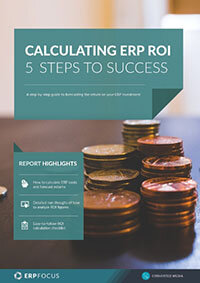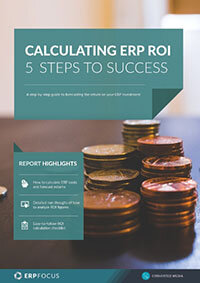How to Identify Returns for an ERP ROI Calculation
Returns – they are the reason you are looking for an ERP system. How will it help? How much will it add to your revenue or reduce from your expenses? These questions can be answered by conducting a thorough analysis of the input variables for an ERP ROI calculation.
Assigning Returns to Requirements
Much of this exercise should already be done. When you first began considering an ERP system you got together with managers, users, and executives from around your enterprise to collect and document the reasons you needed the tools present in ERP. Go back and get your notebook. Dust it off. Start placing dollar, pound, or other units of money next to each reason.
Did a potential customer influence your decision to upgrade ERP? What products and what volume do you think that customer will order now that you are armed with the new system? What is the incremental margin? Those products have related cost of sales but much of your indirect expenses will remain unchanged. You must carefully separate these from your costs to accurately calculate ERP ROI returns.
Recommended Reading: ERP Selection Survival Guide - 10 Steps to Selection Success
What other benefits do you see? Will you be able to produce the same products faster? Does that mean more potential revenue or a chance to drastically reduce overtime costs?
Did you predict you could bring the same materials through your supply chain with two fewer buyers? Easy? Just add up the salary and benefits those buyers were paid. However, this is a catch that many fall into. Unless you actually eliminate those two people from your payroll, you haven’t saved anything yet. Keeping the same number of buyers as you had before the ERP would only mean you are proving Parkinson’s Law and the work will expand to fill the time available.
Forecasting Potential Returns
Another source of return could be revenue protection. Perhaps your quality system was paper-based and held together by one person who is near retirement and has the whole system in their head. The new ERP has all the quality tools you need completely built in and available to any user who needs access. More importantly, the system can be available to customers who demand to see your documentation and to agencies that are concerned with your level of compliance.
During the calculation of ERP ROI, you will probably identify returns you never expected, especially after you begin using the new system.
Many businesses are profitable at the bottom line. Their finance department spread costs among products and processes using a variety of metrics. But that is as close to accurate as you are able to get. Your new ERP could eliminate uncertainty through a much more detailed ship or project costing component that is included. Maybe the overall cost remains unchanged but because you are able to link costs precisely to products you can view profitability in a much smarter way.
Actual and potential returns from ERP come in many flavors. During the calculation of ERP ROI, you will probably identify returns you never expected, especially after you begin using the new system. The most important step in the ERP ROI process is assessing the balance of costs versus returns. Without accurate data going into this funnel, you will get nothing of value at the other end.
Free white paper

Calculating ERP ROI: 5 steps to success
Calculate your new ERP's financial benefits with this comprehensive guide

Featured white papers
Related articles
-
![Three direct links between ERP and manufacturing revenue [image by Snowing on Freepik] Three direct links between ERP and manufacturing revenue [image by Snowing on Freepik]](/pictures/W1siZiIsIjIwMjUvMDEvMjAva2ZwYjAzb3gzX1RocmVlX2RpcmVjdF9saW5rc19iZXR3ZWVuX0VSUF9hbmRfbWFudWZhY3R1cmluZ19yZXZlbnVlX2ltYWdlX2J5X1Nub3dpbmdfb25fRnJlZXBpa18uanBnIl0sWyJwIiwidGh1bWIiLCI0MDB4MjY2IyJdLFsicCIsImVuY29kZSIsImpwZyIsIi1xdWFsaXR5IDg1Il1d/Three%20direct%20links%20between%20ERP%20and%20manufacturing%20revenue%20%5Bimage%20by%20Snowing%20on%20Freepik%5D.jpg?sha=b45b02a140cc8680)
Three direct links between ERP and manufacturing revenue
What you need to know to help you achieve a return on your manufacturing ERP investment
-

CMMC Compliance: What Aerospace and Defense Manufacturers Need to Know
Key insights on CMMC compliance, deadlines, and securing DoD contracts with CMMC 2.0 certificatio...
-
![3 Tips for Achieving Buy-In for Your ERP Integration [by pressfoto on Freepik] 3 Tips for Achieving Buy-In for Your ERP Integration [by pressfoto on Freepik]](/pictures/W1siZiIsIjIwMjQvMTAvMjkvNnQyNmRwdzdwYl8zX1RpcHNfZm9yX0FjaGlldmluZ19CdXlfSW5fZm9yX1lvdXJfRVJQX0ludGVncmF0aW9uX2J5X3ByZXNzZm90b19vbl9GcmVlcGlrXy5qcGciXSxbInAiLCJ0aHVtYiIsIjQwMHgyNjYjIl0sWyJwIiwiZW5jb2RlIiwianBnIiwiLXF1YWxpdHkgODUiXV0/3%20Tips%20for%20Achieving%20Buy-In%20for%20Your%20ERP%20Integration%20%5Bby%20pressfoto%20on%20Freepik%5D.jpg?sha=0e1a55a6cfcac344)
3 tips for achieving buy-in for your ERP integration
Read our expert’s tips on getting your ERP integration project off the ground by achieving busine...


